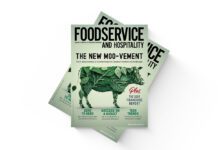Subtle intimacy is not the order of the day at England’s Za Za Bazaar. Lights flash and the music blares as the flames dart from woks and the fat sizzles on grills while a squad of chefs prepare dish after dish (after dish) of trans-global cuisine to hundreds of diners who eagerly stand waiting at various cooking stations spread throughout the site. The fanfare is working: last December, some 60,000 customers flocked to the restaurant that opened in November 2011.
The eatery offers fixed-price, buffet-style dining in the newly redeveloped Harbour area of Bristol, England. “Our concept is centred on offering a ‘high-end’ buffet and is targeting a niche market, which is not being serviced in the U.K. at this time,” says Phillip Maddock, manager of the Bristol operation owned by England’s Maricksons Limited. Celebrated international chef Nitin Bhatnagar, executive chef of Maricksons, is the driving force behind the establishment. “This restaurant is a dream for me,” he says. “We carefully researched the market and truly believe our concept is successful due to the quality, freshness and variety of food we offer, coupled with the personality, skills and individuality of our master chefs.”
Of course, the packaging isn’t too shabby either. “We came up with the bazaar idea, which has a strong outdoor feeling to it,” says Dan Einzig, managing director of the design firm Mystery, the company behind the decor. From the outside, the bright neon lights of the two-storey former nightclub are lively and inviting. Inside the restaurant stretches across 30,000 sq. ft. and caters to 2,000 diners per night with two two-hour dinner sittings. It’s so big, customers are handed a map upon arrival.
The vibrant interior creates a lively atmosphere, which management claims is reminiscent of the “buzzing Asian night markets found in countries such as Thailand or Singapore.” Neon lights create a nighttime effect with the help of festoons of lights strung between pillars and serving counters. Stainless-steel fixtures and fittings run throughout the space and polished chrome serving dishes are used. The polished concrete floor offsets the roughly finished walls; vivid graphic renderings reflect the cultures of the countries represented on the menu.
The ground floor is the smaller space. It features a 300-seat lounge bar, which offers a choice of some 300 drinks drawn from five continents to complement the global cuisine. Upstairs the 700-seat dining room leads to six individual open kitchens manned by up to 36 chefs preparing the all-you-can-eat buffet. The range of world cuisine on offer includes Indian, European, Tex-Mex, Asian, Turkish, Italian, Lebanese, Chinese, South American and Japanese.
Za Za is open seven days a week from 11 a.m. to 11 p.m. When converted to Canadian, the average lunch rings in at approximately $15 while the dinner menu is approximately $23 Monday to Thursday and $26 Friday to Sunday. Children under five eat for free, and it’s half price for kids between five and 11 years old.
“We are delighted at the early success of our new brand,” says Vinay Reddy, executive chef of the Bristol location, while discussing plans to grow the restaurant to a series of eight wholly owned establishments. “It shows that with the right concept, clear planning and committed investment, dynamic new ventures can succeed in the current economic environment while creating much-needed jobs. The challenge we face now is to find sites in the right locations for our large-scale operations. We need big spaces so we can recreate the ambiance of the streets.” While the development of this flagship Bristol site cost nearly $5 million, the other locations are expected to come in at $3 to $4 million with each venue offering from 120 to 150 employment opportunities.
While the opening of Za Za Bazaar has seemingly been warmly accepted by the majority of the local population, not everyone is wildly enthusiastic. Some residents, like Navina Bartlett, have reservations and worry the monster eatery puts pressure on the food stalls, the cafés located along the waterfront and the popular St. Nicholas Market — a five-minute walk away. “Lots of independent traders around here may struggle to compete with something like this. The scale of it is just frightening,” she says. Indeed, it’s a big enterprise, but that hasn’t stopped thousands of diners from lining up to indulge in the Bazaar experience.
Keep Reading
In Conversation With Oliver & Bonacini
Books for Cooks: Come In We’re Closed
New Food Display Concepts Provide Diverse Functionality





















